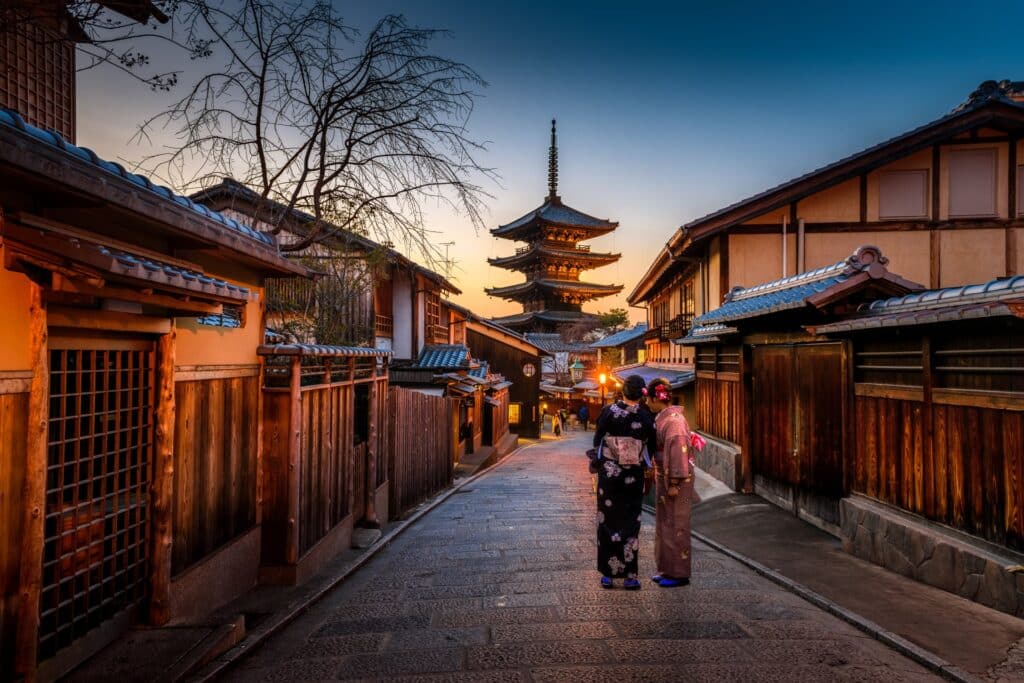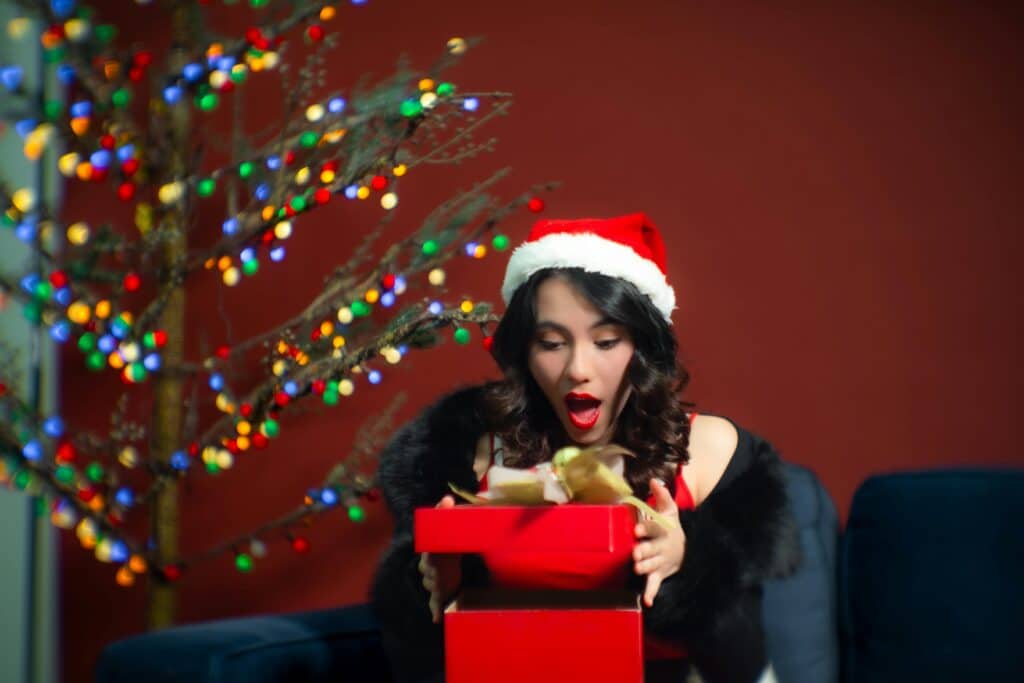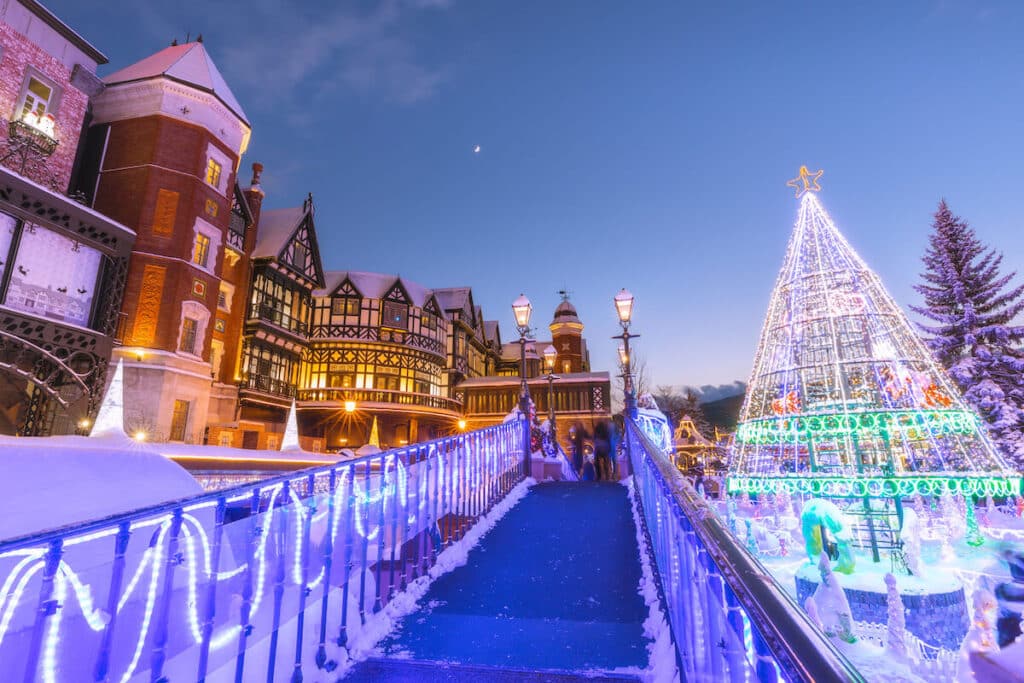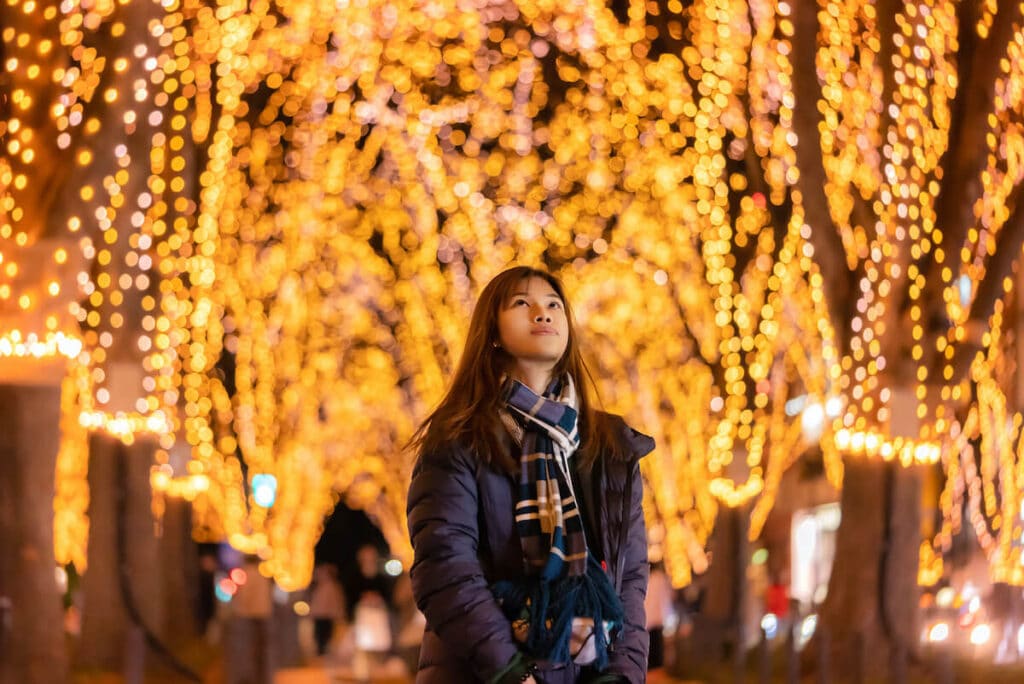
Whether you live in Japan or are a visitor, December is a great time of year to experience unique Japanese Christmas traditions. If you’ve grown up celebrating Christmas in Western countries, some of these customs may look a bit different to you. Christmas in Japan has more in common with Christmas in South Korea, which evolved from a Christian observation to a more secular one.
Keep reading this Remitly guide to learn about popular activities during the Christmas season, as well as some special traditions to take part in on Christmas Eve.
Table of Contents
What is the History of Christmas in Japan?
Shintoism and Buddhism are the most common religions in Japan, with only 1.5% of the population identifying as Christian. But that doesn’t mean the Japanese don’t recognize Christmas. Rather people in Japan celebrate Christmas as a secular day rather than a religious holiday.
There’s no such thing as a “traditional” Japanese Christmas, but the small population of Christians that live in the country have celebrated it for centuries. In 1552, a missionary named Francis Xavier held the first recorded Christmas celebration in the country. He officiated a church service and then donated to poor farmers in the area surrounding his mission.
Under the Tokugawa Shogunate military government, which ruled from 1603 to 1868, Christianity was forbidden in Japan. Anyone practicing the religion could face crucifixion and other means of execution.
As a result, Christians worshiped in secret and were unlikely to hold Christmas celebrations. In 1873, the Meiji government eliminated the ban, allowing Christians to celebrate openly.
It was during the 20th century that Christmas really took off in Japan. A luxury grocery store called Meijiya made headlines in 1904 by displaying a Christmas tree in its window. The trendy shop inspired competitors to do the same in the following years.
After World War II, Christmas continued to grow in popularity throughout the country. When the Japanese economy boomed during the 1980s, gift-giving during the holiday season became a way to show one’s status and connections to Western culture.
How do you say “Merry Christmas” in Japan?
In Japan, they call Christmas “Kurisumasu,” and the phrase for “Merry Christmas” is “Merii Kurisumasu.” The phrase is a phonetic pronunciation of the English greeting. To pronounce it, say “MAY-ree KU-ree-sue-mah-sue.”
In the katakana writing system, “Merry Christmas” is written as メリー クリスマス. The hiragana characters are めりーくりすます.
Is there a Santa Claus in Japan?
Santa Claus has become an icon of the holiday season in Japan. This is primarily due to marketing campaigns that use the image of the jolly man in a red suit to promote sales and products. Japanese people refer to him as “Santa-San” or “Mr. Santa.” His name is written as サンタさん in hiragana and サンタクロース in katakana.
Many Japanese parents incorporate the Santa Claus tradition into their Christmas celebrations. Japanese children write letters to Santa. In 2020, the overseas courier service ANA Group even loaded an airplane with 800,000 letters and flew them to Savalen, Norway, where Santa waited with his sleigh to accept them.
Santa isn’t the only one who brings gifts for children. Kids may also receive presents from Hotei, one of the shichifukujin, or Seven Lucky Gods. Sometimes called the laughing Buddha, Hotei is a joyful, pot-bellied figure who carries a magical sack filled with unknown objects. Hotei is a protector of children, and some Japanese people include presents from him as a part of the Christmas season.
How do Japanese People Decorate for Christmas?
North American and European cultures inspire Christmas decorations in Japan. Many businesses and families decorate artificial trees with ornaments, bells, and candy canes, but a Japanese Christmas tree may also feature paper fans, origami birds and animals, and paper lanterns.
Stores sometimes get creative with their Christmas trees. They may hang merchandise from the branches or arrange goods for sale in pyramid displays and decorate them as if they were trees.
In Japan, Christmas lights are also commonly hung in public places. In Tokyo, the entire Marunouchi neighborhood glows with lights. Special festivals of lights are held at the Caretta Shiodome and Country Farm Tokyo German Village.
The cities of Osaka, Nagoya, Kobe, Kanagawa, Sapporo, and Kyoto also host light displays. Typically, LED string lights are used to provide festive lighting, but some locations incorporate traditional lanterns.
How do Japanese People Celebrate Christmas?
In many parts of the world, Christmas is a time for family, and New Year’s is for celebrations with friends. Japanese people celebrate the winter holidays in opposite ways.
Japanese people typically view Christmas as a romantic holiday for couples. This is similar to how South Korea celebrates Christmas, with the holiday closely resembling Valentine’s Day. Young couples may go out for dinner or spend the holiday at a Christmas party.
Christmas is not a public national holiday in Japan, so Japanese people often work during the day and then have a special dinner with their romantic partner at night.
Many schools begin winter break on December 25, so children are usually off for the day. Couples with children may make Christmas Day a festive occasion for their little ones instead of having a romantic evening together.
Some families organize large parties and invite classmates to attend. Tokyo Disneyland has parades and performances throughout November and December, and many Japanese people visit the theme park to get into the spirit of the holiday.
New Year’s Day is when families come together under one roof to share a meal. Many businesses close for this public holiday so employees can spend it with loved ones.
Do Japanese people give gifts for Christmas?
Gift-giving plays an important role in Japanese culture throughout the year, so it’s no surprise that it’s common at Christmas. In fact, the winter season is perhaps the busiest time to visit shopping malls and shopping centers.
The people of Japan are known for giving gifts to loved ones, friends, and business contacts. If you’re celebrating Christmas there, knowing the etiquette surrounding giving, receiving, and exchanging gifts is important.
- Always hold a gift in both hands when offering it to someone.
- The value of the gift value should match social status. For example, your boss should receive a more expensive gift than a coworker.
- Giving gifts in pairs or in sets of three or eight is considered lucky. Giving gifts in sets of four is unlucky.
- Accept a gift with both hands and say thank you.
- Wait to open a gift immediately upon receiving it. Set it aside and open it later, in private.
- Packaging is important. Use attractive gift wrap and a bow, or place the gift in a decorative bag. You can make your gift more traditional by using furoshiki, a fabric wrapping paper. Avoid gift wrap in the color red, which is associated with funerals in Japan. Green, a symbol of good luck, is a good color choice for gift wrap.
- Prepare for refusal. Japanese people may refuse to accept a gift one, two, or even three times before taking it. To appear modest, you should politely decline the first time, too.
In addition to Christmas gifts, the Japanese also give winter gifts called “Oseibo” between late November and December 20. Giving a winter gift is customary to show gratitude to people in your life.
Anything consumable or useful, like food, snacks, wine, beer, candles, soaps, and toiletries, is commonly exchanged for Oseibo. Steer clear of anything associated with work, like stationery.

What are Japan’s Traditional Christmas Foods?
Modern Japanese Christmas traditions do include food, but meals are often shared between couples rather than among large gatherings of friends and family.
What is the Most Popular Meal for Christmas in Japan?
If you want to celebrate the holiday in the most popular way, plan to get KFC for Christmas dinner in Japan.
In the 1970s, the fast-food retailer launched an ad campaign encouraging Japanese people to split a bucket of fried chicken as a Christmas meal. It turned out to be wildly successful, and now, around 3.6 million people in Japan eat KFC (formerly known as Kentucky Fried Chicken) for Christmas every year. Fried chicken is the most popular holiday food, with 58.2% of the Japanese population eating it yearly.
Due to the popularity of its chicken, KFC, and other retailers typically require advance orders for the holidays. When they don’t, they may have lines out the door, leaving those who didn’t plan ahead waiting hours to buy fried chicken.
A KFC holiday dinner usually includes either fried chicken pieces or whole-roasted chicken plus sides. It also typically comes with a beverage called “Chanmery.” A favorite with kids, this beverage combines a champagne-style carbonated drink and grape juice and usually comes in whimsical packaging decorated with cartoon characters.
What are Some Sweet Japanese Christmas Foods?
KFC isn’t the only thing on the menu for Japanese families during Christmas. Almost as popular is the Christmas cake, a two-layer white sponge cake with whipped cream icing. Strawberries decorate the top, and some bakers also add them to the filling.
The color scheme of these classic Christmas cakes represents the Japanese flag. The strawberry shortcake emoji 🍰 found in the standard emoji library is based on this Christmas treat.
In addition to Japanese Christmas cake, many people eat wagashi for Christmas. These small sweets are typically enjoyed with a cup of green tea. There are dozens of kinds, but some of the most well-known are mochi rice cakes, sweet white bean paste nerikiri, sweet potato paste, imo yokan, and mitarashi dango rice dumplings. For the holidays, you will sometimes find wagashi shaped like Christmas trees, Santa, reindeer, and snowmen.
4 Unique Christmas Traditions in Japan
Now that you know what to expect from Christmas in Japan, what Japanese traditions should you put on your to-do list? Here are six of the most popular ways to celebrate while visiting the island nation, including some familiar activities with a unique spin.

Now that you know what to expect from Christmas in Japan, what Japanese traditions should you put on your to-do list? Here are six of the most popular ways to celebrate Christmas in Japan, including some familiar activities with a unique spin.
1. Visit a German Christmas Market.
One of the unique things about Christmas in Japan is that you’ll find cultural influences from all over the world. Some of Japan’s popular Christmas traditions come from Germany, including the Christmas markets everywhere from Osaka to Yokohama. You can enjoy mulled wine, bratwurst, gingerbread, and more.
Two of the biggest markets are the Tokyo Christmas Market, located in Hibya Park and sponsored by the German Tourism Association, and the Munich Christmas Market in Sapporo, both running for several weeks each December. If you want to ice skate, eat warm and hearty German-style Christmas food, or take the kids to sit for a photo with Santa, this is the place to go.
2. Listen to Beethoven’s Ninth.
Music is a big part of Christmas culture worldwide, but Japan has a unique musical Christmas tradition. Instead of popular Christmas carols, the centerpiece is Beethoven’s Ninth Symphony called Daiku, the Japanese word for “Ninth.”
You may hear the Ninth playing on department store speakers, but to fully embrace this tradition, attend a live choral performance or even sing in it yourself. The SUNTORY 10,000 Freude choir in Osaka includes over 10,000 performers of all ages.
According to National Geographic, the Daiku tradition began during World War II when German prisoners of war introduced the song to a Japanese audience. This exchange of German and Japanese culture led to a long-standing tradition in Japan.

3. See the Winter Illuminations.
You don’t have to look hard to find Christmas lights in Japan, but some places are more lit up than most. Train stations are some of the best spots to see the illuminations.
Kyoto Station is famous for the large Christmas tree in the atrium and the LED lights on the grand staircase, while the iconic Arashiyama walkways are lit up with lanterns. The Tokyo districts of Roppongi and Harajuku are also decked out with winter illuminations, and Tokyo Station has a massive display of its own.
4. Visit Tokyo Disneyland.
If you don’t find enough holiday spirit while wandering the streets of Tokyo or Kyoto, you can spend Christmas at Tokyo Disneyland. This Disney theme park opened in 1983, and it celebrates the season with almost two full months of activities in November and December.
Japanese children and tourists come here to enjoy the Christmas parades, meet Santa, and participate in other seasonal activities. Christmas music plays throughout the park throughout the day, adding to the festive mood.
Send Money to Japan for the Holidays
From illuminations to Daiku performances, there are plenty of ways to celebrate Christmas in Japan. Japanese Christmas traditions don’t revolve around gift-giving, so you don’t have to put presents under a Christmas tree. But, it’s common for couples to exchange gifts with each other and for families to exchange gifts on New Year’s.
If you’re on your way to Japan for the winter holidays, be sure to exchange your money into yen so you can get the best deals on your purchases by using the local currency.
And if you can’t be there to spend time with your family and loved ones, consider sending money abroad for a Christmas cake or Christmas dinner. The Remitly team wants to wish a very “Meri Kurisumasu“ to all those with loved ones in Japan. We hope you enjoy some of these Japanese Christmas traditions and have a happy New Year!

FAQS
It was during the 20th century that Christmas really took off in Japan. A luxury grocery store called Meijiya made headlines in 1904 by displaying a Christmas tree in its window. The trendy shop inspired competitors to do the same in the following years.
A unique Japanese Christmas tradition is eating Kentucky Fried Chicken (KFC) on Christmas Day! Since a successful marketing campaign in the 1970s, KFC has become the go-to meal, with people reserving their “Christmas chicken” in advance. This quirky tradition has turned a typical American fast food into a festive must-have across Japan.
In Japan, Christmas decorations are often vibrant and elaborate, with cities, shopping centers, and public spaces lighting up with beautiful displays. LED light shows, known as “illuminations,” are especially popular and draw large crowds.